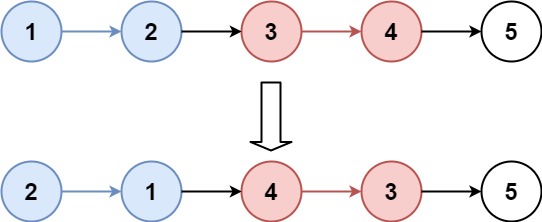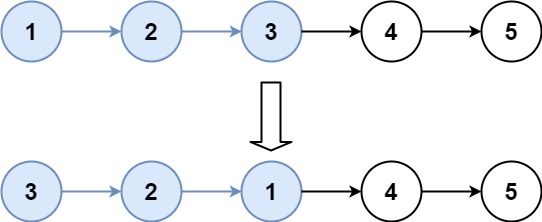LeetCode-in-All
25. Reverse Nodes in k-Group
Hard
Given a linked list, reverse the nodes of a linked list k at a time and return its modified list.
k is a positive integer and is less than or equal to the length of the linked list. If the number of nodes is not a multiple of k then left-out nodes, in the end, should remain as it is.
You may not alter the values in the list’s nodes, only nodes themselves may be changed.
Example 1:

Input: head = [1,2,3,4,5], k = 2
Output: [2,1,4,3,5]
Example 2:

Input: head = [1,2,3,4,5], k = 3
Output: [3,2,1,4,5]
Example 3:
Input: head = [1,2,3,4,5], k = 1
Output: [1,2,3,4,5]
Example 4:
Input: head = [1], k = 1
Output: [1]
Constraints:
- The number of nodes in the list is in the range
sz. 1 <= sz <= 50000 <= Node.val <= 10001 <= k <= sz
Follow-up: Can you solve the problem in O(1) extra memory space?
To solve the “Reverse Nodes in k-Group” problem, you can use the following approach:
Approach:
- Check if Reversal is Possible:
- Before reversing, check if there are at least
knodes remaining in the linked list.
- Before reversing, check if there are at least
- Reverse Nodes:
- Reverse the next
knodes of the linked list.
- Reverse the next
- Connect the Reversed Portion:
- Connect the reversed portion to the previous part of the linked list.
- Update Pointers:
- Move the pointers to their correct positions for the next iteration.
- Repeat:
- Repeat the process until there are fewer than
knodes left.
- Repeat the process until there are fewer than
- Return Result:
- Return the modified head of the linked list.
Python Code:
class ListNode:
def __init__(self, val=0, next=None):
self.val = val
self.next = next
class Solution:
def reverseKGroup(self, head, k):
# Function to reverse a linked list
def reverseList(start, end):
prev, curr = None, start
while curr != end:
next_node = curr.next
curr.next = prev
prev = curr
curr = next_node
return prev
# Initialize pointers
dummy = ListNode(0)
dummy.next = head
prev, curr = dummy, head
# Find the length of the linked list
length = 0
while head:
length += 1
head = head.next
# Reverse nodes in k-group
while length >= k:
end = curr
for _ in range(k - 1):
end = end.next
# Reverse k nodes
next_start = end.next
reversed_start = reverseList(curr, next_start)
# Connect reversed portion to the previous part
prev.next = reversed_start
curr.next = next_start
# Move pointers for the next iteration
prev, curr = curr, next_start
length -= k
# Return the modified head
return dummy.next
# Example Usage:
solution = Solution()
# Example 1:
head1 = ListNode(1, ListNode(2, ListNode(3, ListNode(4, ListNode(5)))))
result1 = solution.reverseKGroup(head1, 2) # Output: ListNode(2, ListNode(1, ListNode(4, ListNode(3, ListNode(5))))))
# Example 2:
head2 = ListNode(1, ListNode(2, ListNode(3, ListNode(4, ListNode(5)))))
result2 = solution.reverseKGroup(head2, 3) # Output: ListNode(3, ListNode(2, ListNode(1, ListNode(4, ListNode(5))))))
# Example 3:
head3 = ListNode(1, ListNode(2, ListNode(3, ListNode(4, ListNode(5)))))
result3 = solution.reverseKGroup(head3, 1) # Output: ListNode(1, ListNode(2, ListNode(3, ListNode(4, ListNode(5)))))
# Example 4:
head4 = ListNode(1)
result4 = solution.reverseKGroup(head4, 1) # Output: ListNode(1)
This code defines a Solution class with a method reverseKGroup that takes a linked list and an integer k as input and reverses every k nodes in the linked list. The example usage demonstrates how to create an instance of the Solution class and call the reverseKGroup method with different inputs.

